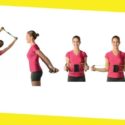All You Need to Know About Diastasis Recti Repair
Contents
ToggleWhat is Diastasis Recti?
Diastasis recti, also known as abdominal separation, is a condition characterized by the stretching and separation of the rectus abdominis muscles, which are the “six-pack” muscles that run down the front of the abdomen. Normally, these muscles are held together by a connective tissue called the linea alba. However, during pregnancy or due to other factors, the linea alba can become weakened, leading to a separation of the abdominal muscles.
Diastasis recti is commonly seen in pregnant women, particularly during the second and third trimesters when the growing uterus puts increased pressure on the abdominal muscles. However, it can also occur in men and women who are not pregnant due to factors such as obesity, multiple pregnancies, incorrect core exercises, aging, and genetics.
How to Know if You’ve Diastasis Recti?
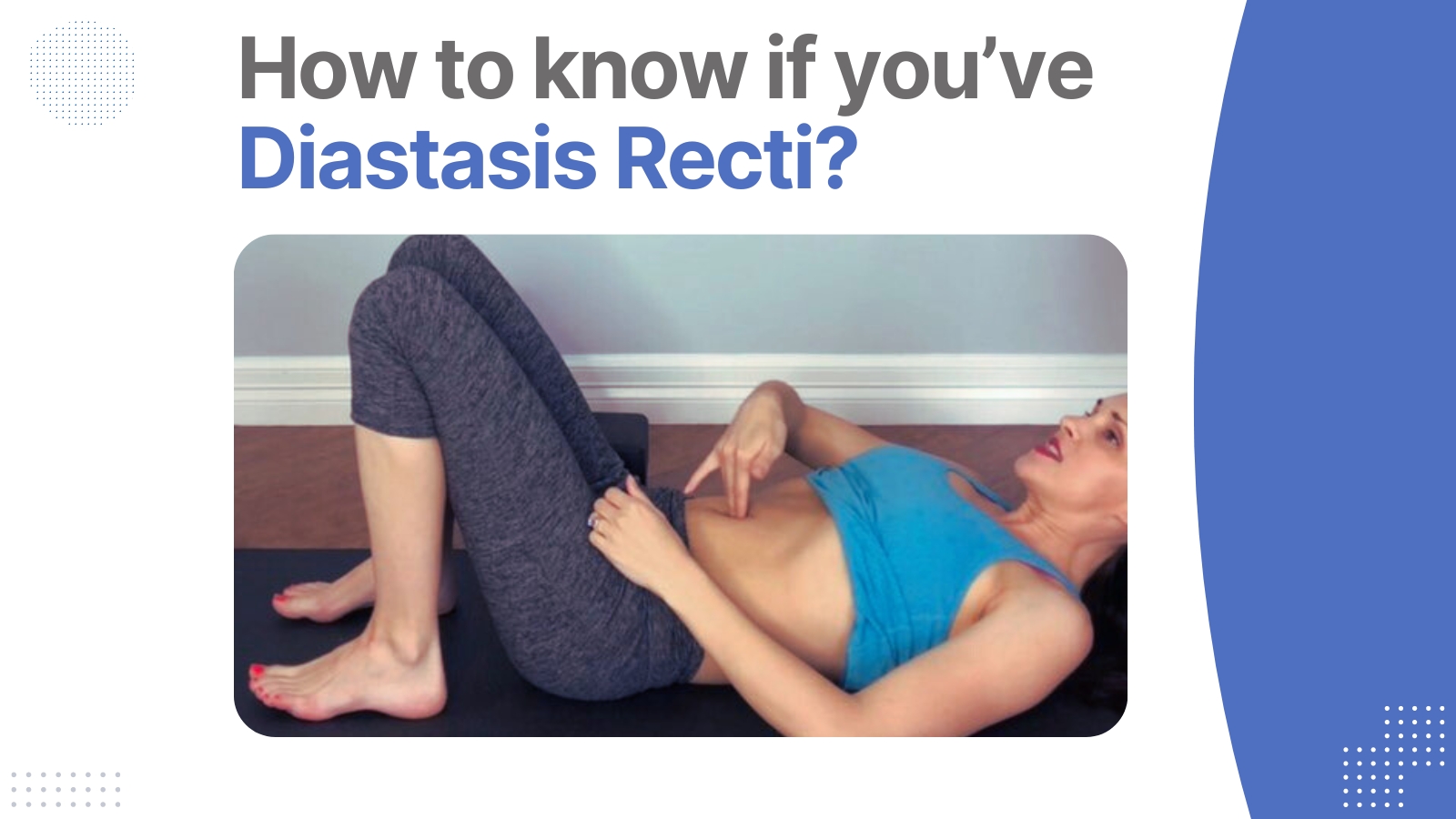
Source: @pregnancyandpostpartumtv
Common symptoms of diastasis recti include a noticeable bulge or ridge in the middle of the abdomen when lying down and performing certain movements, such as sit-ups or crunches. It is essential to note that diastasis recti is not a hernia, as the abdominal organs remain behind the muscle and do not protrude through the separation.
Diastasis recti is the condition which is characterized by the separation of the abdominal muscles, hence to check if you might have diastasis recti, you can perform a simple self-assessment called the “diastasis recti test.” Here’s how you can do it:
Find a comfortable, flat surface. Lie on your back on a firm surface, such as the floor or a yoga mat. Bend your knees and place your feet flat on the ground with your knees bent. This position helps relax the abdominal muscles. Locate your belly button and identify the position of your belly button. Check for separation by gently placing your fingers horizontally just above your belly button. Press down lightly and lift your head slightly off the ground as if doing a mini crunch. Try to feel for a gap or space between the left and right sides of your rectus abdominis muscles which we all recognize as the “six-pack” muscles. Measure the gap, if there is a separation, you can measure its width using your fingers. A diastasis recti gap is typically measured in finger-widths. For example, one finger-width would indicate a mild separation, while three or more finger-widths could be considered more severe.
How to Fix Diastasis Recti Years Later?
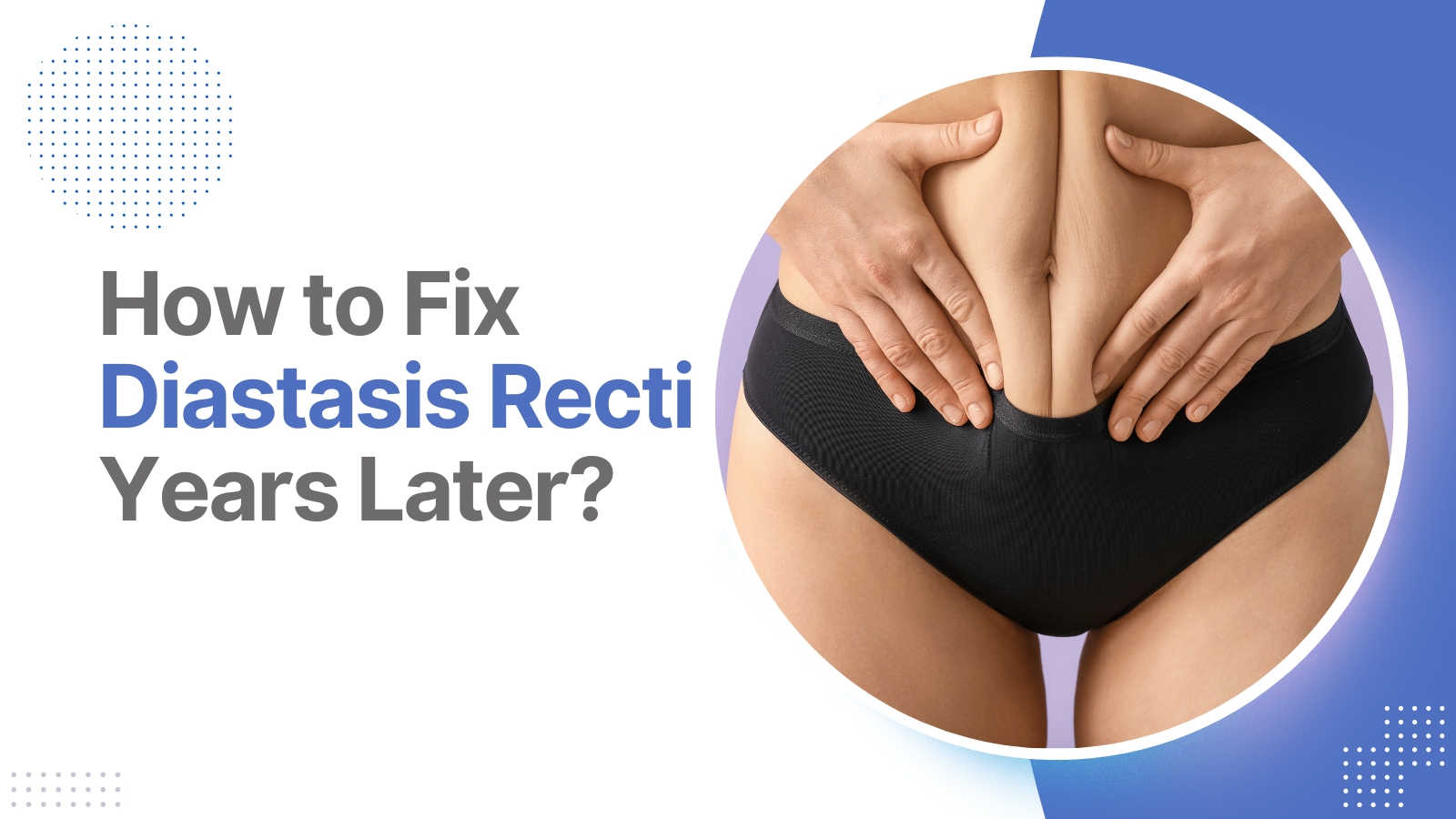
Fixing diastasis recti years later is possible with the right approach and consistent effort. However, it may take longer to see results compared to addressing it shortly after childbirth, the following steps can help improve diastasis recti over time:
1. Consult with a healthcare professional
Before starting any exercises or treatment, it’s crucial to consult with a physical therapist or healthcare provider who specializes in diastasis recti. They can assess your condition, provide personalized advice, and recommend appropriate exercises based on your specific needs and level of separation.
2. Core exercises
Engage in targeted exercises that focus on strengthening the deep abdominal muscles and the transverse abdominis, which act like a natural corset to support the abdomen. Common exercises include pelvic tilts, abdominal compressions, and modified planks. Avoid traditional sit-ups or crunches, as they can worsen diastasis recti and changes post diastasis recti repair.
3. Breathing techniques
Learning proper breathing techniques can help activate the deep abdominal muscles and improve their function. Diaphragmatic breathing and coordinating breath with pelvic floor activation can be beneficial.
4. Posture awareness
Pay attention to your posture throughout the day. Avoid slouching and engage your core muscles to support your spine and abdominal area.
5. Bracing techniques
During daily activities that require abdominal effort, such as lifting, use proper bracing techniques to protect the abdominal muscles. This involves gently pulling the navel towards the spine while maintaining normal breathing.
6. Supportive garments
Consider wearing supportive garments like postpartum abdominal binders or compression clothing to help support the abdominal muscles.
7. Gradual progress
Be patient and consistent with your efforts. Progress may take time, so focus on gradual improvement rather than expecting instant results.
8. Avoid straining the abdomen
Be cautious during exercises or activities that put excessive strain on the abdominal muscles, such as heavy lifting, intense core workouts, or movements that cause coning or doming in the midline.
9. Maintain a healthy weight
If you are overweight, achieving and maintaining a healthy weight can help reduce additional stress on the abdominal muscles.
10. Surgical intervention
In some cases of severe diastasis recti that do not respond to conservative methods, surgical intervention may be considered. In some cases, laparoscopic diastasis recti repair is also recommended which is also known as laparoscopic ventral hernia repair. It is a surgical procedure used to treat diastasis recti and ventral hernias. The laparoscopic approach is a minimally invasive surgical technique, meaning it involves making several small incisions rather than one large incision used in traditional open surgery.
Diastasis Recti Before and After
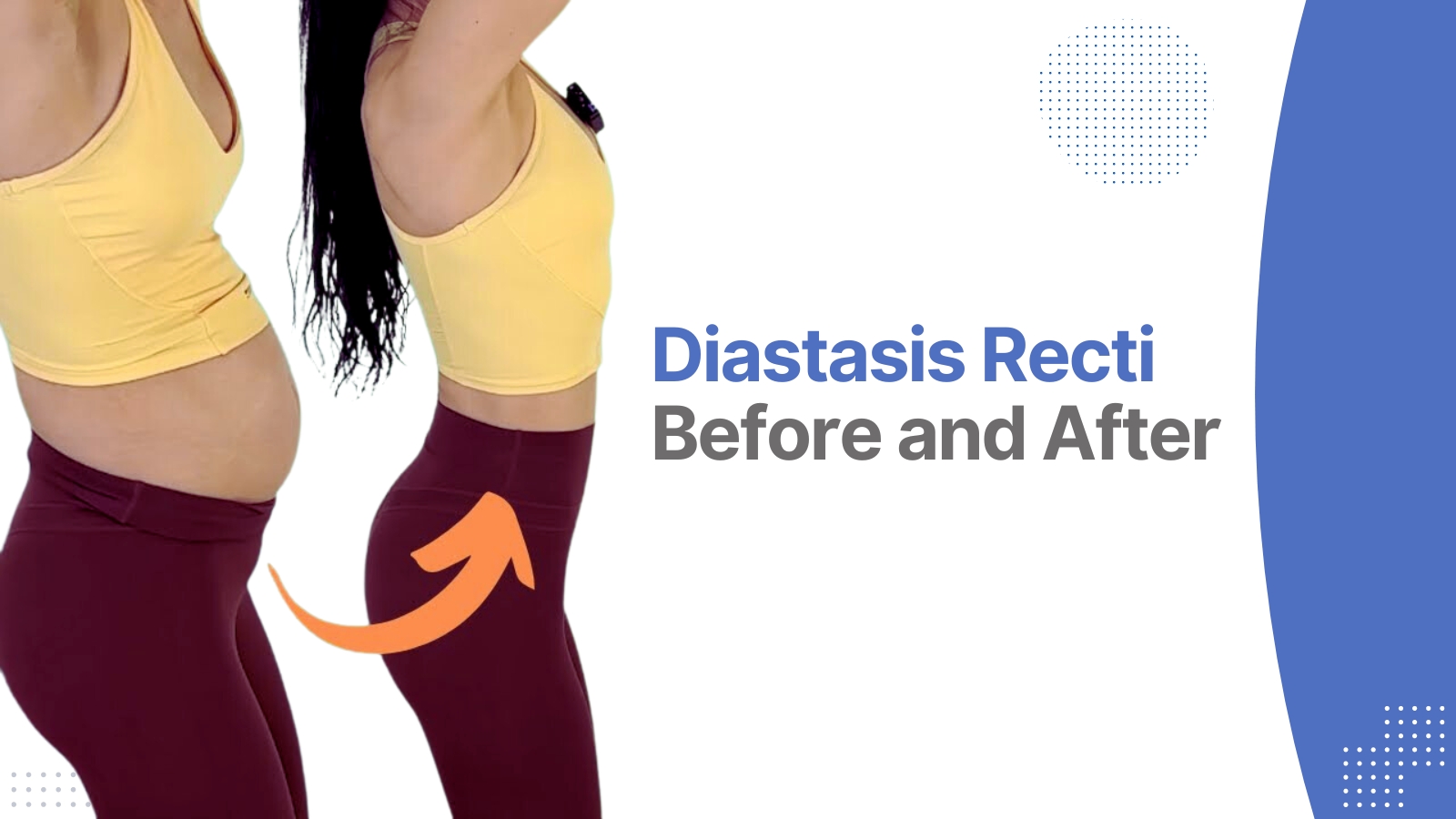
Source: @pregnancyandpostpartumtv
The severity of diastasis recti can vary from person to person, and the extent of improvement after treatment can also differ based on factors such as the individual’s age, the severity of the separation, muscle strength, and consistency in following treatment recommendations.
Before treatment, the diastasis recti may be evident as a visible ridge or gap in the midline of the abdomen, especially during certain movements like getting up from a lying position or performing certain exercises.
However, after treatment, particularly with focused exercise and physical therapy, the following changes may be observed that include reduced separation with targeted exercises and appropriate therapy, the gap between the rectus abdominis muscles can gradually decrease. This results in a more compact and aligned appearance of the abdomen.
Also, one can notice improved core strength, as the abdominal muscles strengthen, they provide better support for the internal organs and spine, leading to improved core stability and functionality and decreased bulging which is the visible bulge or ridge in the midline of the abdomen may diminish or become less prominent as the abdominal muscles regain their tone.
Some other apparent evident changes post diastasis recti repair are better posture, including strengthening the core muscles can positively influence overall posture and reduce the strain on the lower back and some symptom relief as some individuals with diastasis recti may experience symptoms such as back pain or urinary incontinence. After treatment, these symptoms may improve or resolve.
How Long It Takes to Heal Diastasis Recti?
The time it takes for diastasis recti to heal can vary significantly from person to person. Several factors influence the healing process, including the severity of the separation, individual muscle strength and tone, consistency with exercises and treatment, and overall lifestyle habits.
In some cases, mild diastasis recti may improve on its own over time, especially with proper awareness of posture and core engagement during daily activities. However, for more moderate to severe cases, targeted exercises and physical therapy are typically recommended to promote healing. With consistent and appropriate exercises, many individuals may start to notice improvements within a few weeks or months. However, complete healing may take several months to a year or more, depending on the individual’s progress and commitment to the treatment plan.
It’s very important to approach diastasis recti healing with patience and realistic expectations. Quick fixes or rapid improvement should not be one’s primary focus. Additionally, postpartum women should be aware that diastasis recti healing may take longer if they plan to have more children, as subsequent pregnancies can also put additional stress on the abdominal muscles.
Exercises to Avoid Diastasis Recti
If you have diastasis recti or are at risk of developing it, there are certain exercises you should avoid as they can worsen the condition or put excessive strain on the abdominal muscles. It’s essential to consult with a healthcare professional, such as a physical therapist, before starting any exercise routine to ensure it is safe and appropriate for your specific condition. That being said, here are some exercises to generally avoid when dealing with diastasis recti:
(a) Traditional sit-ups and crunches
These exercises involve flexing the upper body forward, which can put significant pressure on the abdominal muscles and worsen the separation.
(b) Planks
Standard plank positions can increase intra-abdominal pressure, potentially exacerbating diastasis recti. Modified plank variations might be better suited for individuals with the condition, but only under the guidance of a professional.
(c) Russian twists and oblique twists
These exercises involve twisting the torso, which can strain the abdominal muscles and potentially worsen the separation.
(d) Double leg lifts
Lying on your back and lifting both legs together can put pressure on the abdominal muscles and the connective tissue.
(e) Leg raises
Lifting both legs while lying on your back can put stress on the abdominal muscles and should be avoided, especially if the diastasis recti is severe.
Instead of these exercises, consider focusing on activities that support and strengthen the core without putting excessive stress on the abdominal muscles that are also recommended by doctors even post diastasis recti repair.
Recommended Exercises for Individuals With Diastasis Recti
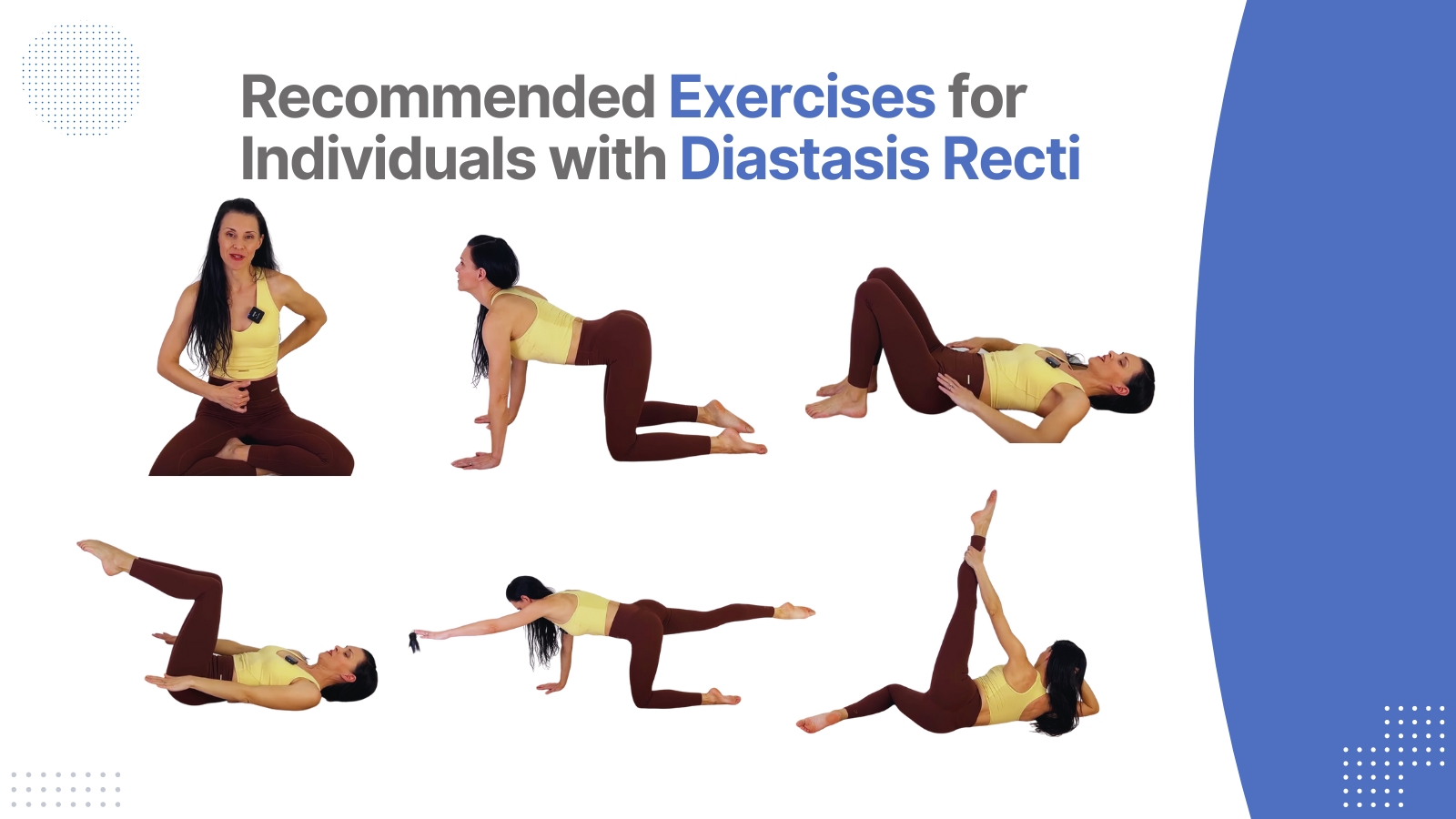
Source: @pregnancyandpostpartumtv
(a) Pelvic tilts
Gently tilting the pelvis while lying on your back can activate the deep abdominal muscles without putting pressure on the rectus abdominis.
Transverse abdominal exercises: Learning to engage the transverse abdominis muscles, often referred to as the “corset” muscles, can help provide support to the abdominal area.
(b) Diaphragmatic breathing
Proper breathing techniques can help engage the core muscles without straining the abdominal area.
(c) Modified plank variations
Some plank modifications, such as forearm planks or incline planks, can be more suitable for individuals with diastasis recti.
(d) Bridges
Lying on your back and gently lifting the hips can engage the glutes and core muscles without putting excessive stress on the abdomen.
Recommended Video: Heal & Flatten With These Daily Diastasis Recti Exercises!
Yoga for Diastasis Recti
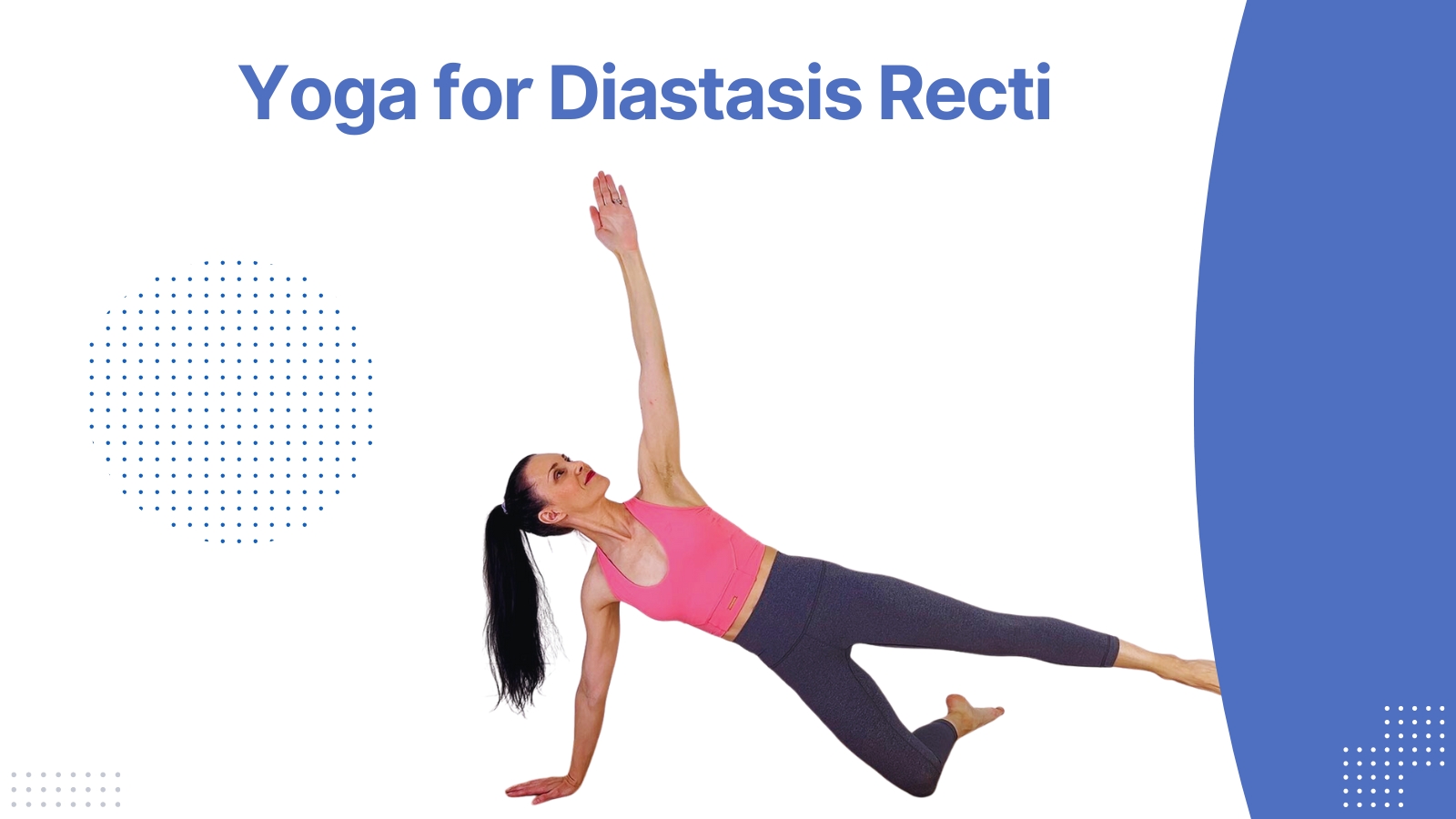
Yoga can be beneficial for individuals with diastasis recti, but it’s crucial to approach it with caution and choose specific poses that are safe for your condition. Some yoga poses can put strain on the abdominal muscles, potentially worsening diastasis recti if not performed correctly. It’s recommended to consult with a healthcare professional, such as a physical therapist or a yoga instructor with experience in working with diastasis recti, before starting a yoga practice.
Here are a few yoga poses that are generally recommended and considered safe for individuals for effective diastasis recti repair:
- Cat-Cow Stretch
- Child’s Pose (Balasana)
- Supported Bridge Pose
- Cobra Pose (Bhujangasana)
- Modified Side Plank (Vasisthasana)
Source: @PregnancyandPostpartumTV
But, always consult with a healthcare professional to create a personalized and safe yoga practice that addresses your specific needs and concerns related to diastasis recti.
Frequently Asked Questions
What does diastasis recti refer to?
Diastasis recti, also known as abdominal separation, is a condition characterized by the stretching and separation of the rectus abdominis muscles, which are the “six-pack” muscles that run down the front of the abdomen.
What are the symptoms of diastasis recti?
Common symptoms of diastasis recti include a noticeable bulge or ridge in the middle of the abdomen when lying down and performing certain movements, such as sit-ups or crunches.
How do I know if I have diastasis recti?
To test for diastasis recti, you can perform a simple self-assessment called the “diastasis recti test.” This involves lying on your back on a flat surface, identifying the position of your belly button and gently placing your fingers horizontally just above your belly button. You can then lift your head slightly off the ground as if doing a mini crunch and try to feel for a gap or space between the left and right sides of your rectus abdominis muscles.
How to fix diastasis recti?
Fixing diastasis recti is possible with the right approach and consistent effort. Approaches include:
- Consult with a healthcare professional.
- Engage in targeted exercises that focus on strengthening the deep abdominal muscles and the transverse abdominis.
- Learn proper breathing techniques.
- Pay attention to your posture throughout the day.
- Use proper bracing techniques during daily activities that require abdominal effort.
- Consider wearing supportive garments.
- Be patient and consistent with your efforts.
- Avoid exercises or activities that put excessive strain on the abdominal muscles.
- Maintain a healthy weight.
- In some cases of severe diastasis recti that do not respond to conservative methods, surgical intervention may be considered.
How long does it take to heal diastasis recti?
The time it takes for diastasis recti to heal can vary significantly from person to person based on factors such as the severity of the separation, individual muscle strength and tone, consistency with exercises and treatment and overall lifestyle habits. With consistent and appropriate exercises, many individuals may start to notice improvements within a few weeks or months. However, complete healing may take several months to a year or more, depending on the individual’s progress and commitment to the treatment plan.
What exercises should I avoid with diastasis recti?
Exercises to avoid when dealing with diastasis recti include traditional sit-ups and crunches, planks, Russian twists and oblique twists, double leg lifts, and leg raises.
What are some recommended exercises for individuals with diastasis recti?
Recommended exercises for individuals with diastasis recti include pelvic tilts, transverse abdominal exercises, diaphragmatic breathing, modified plank variations and bridges.
Is yoga beneficial for individuals with diastasis recti?
Yoga can be beneficial for individuals with diastasis recti, but it’s crucial to approach it with caution and choose specific poses that are safe for your condition. It’s recommended to consult with a healthcare professional before starting a yoga practice.
You may like this
Recommended For You
Why is Smoking a Big No for Your Dental Health?
Priyadarshini Muduli
A full time passionate writer with imperishable determination to bring healthy, smart and pragmatic changes individually and socially. Concentrate especially on lifestyle, life and personal improvement, relationships, mental health and behavior, viral issues and literature based subjects.



